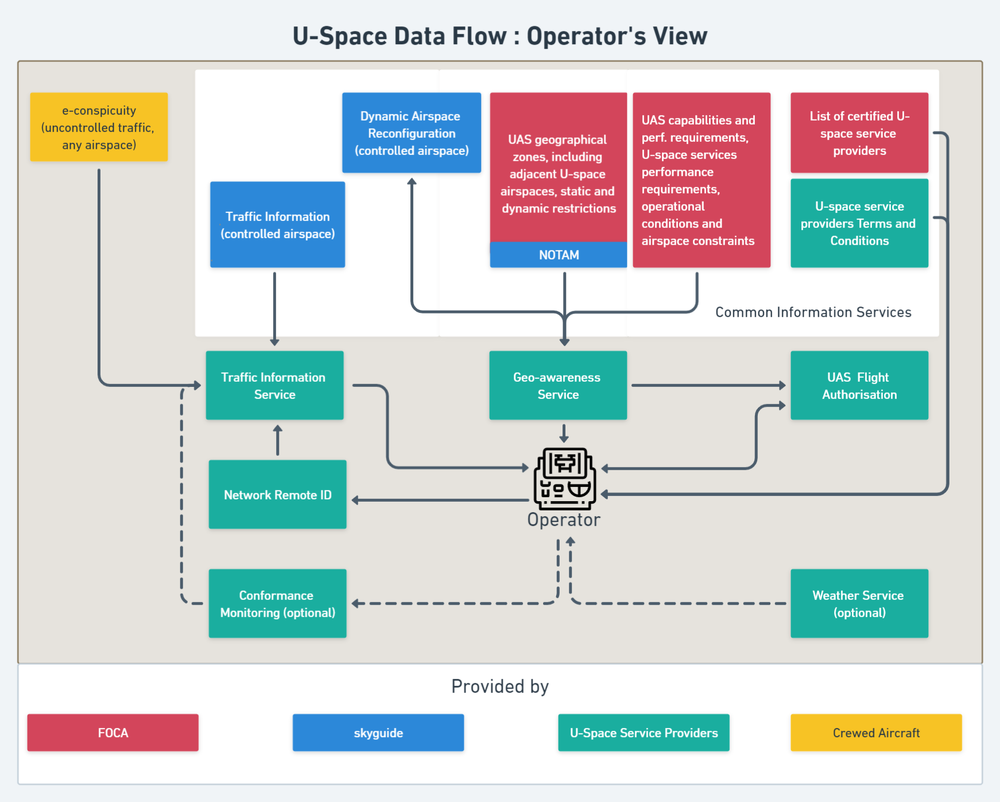Main Page
This version of the Swiss U-Space ConOps coincides with the implementation of a set of three European regulations, collectively know as the U-space regulatory package:
- Implementing Regulation (EU) 2021/664 on a regulatory framework for the U-space
- Implementing Regulation (EU) 2021/665 amending Implementing Regulation (EU) 2017/373 as regards requirements for providers of air traffic management/air navigation services and other air traffic management network functions in the U-space airspace designated in controlled airspace
- and Implementing Regulation (EU) 2021/666 amending Regulation (EU) No 923/2012 as regards requirements for manned aviation operating in U-space airspace
It is currently based on the Notice of Proposed Amendment 2021-14, Development of acceptable means of compliance and guidance material to support the U-space regulation which proposes proposes acceptable means of compliance (AMC) and guidance material (GM) to the U-space regulatory package. A final version of the document is expected toward September 2021.
The document introduces significant changes in comparison with the previous version of the ConOps (1.1)[1]. It is, therefore, numbered as 2.0. The following pages lay out details on the national implementation of the services and capabilities defined in the U-space regulatory package and their acceptable means of compliance (AMC) and guidance materials (GM)[2]. This ConOps remains a living document that will be informed by stakeholders consultations and the knowledge gained as we collect operational experiences.
Stakeholders
The main stakeholders of U-space[3] are:
- the Federal Office of Civil Aviation (FOCA)
- other competent authorities, including the national air navigation service provider, skyguide, as well federal, regional and local authorities.
- UAS operators, when operating in a U-space airspace in the Open, Specific or Certified categories[4]
- U-space service providers
- traditional aviation
- the general public
For more details, see U-space roles and responsibilities
U-space airspaces
A U-space airspace[5] is as a UAS geographical zone[6] designated by FOCA, where UAS operations are only allowed to take place with the support of U-space services. A U-space airspace can be designated for safety, security, privacy or environmental reasons on the basis of an airspace risk assessment carried out by FOCA[7], in coordination with other authorities and entities, including at local level.[8]
U-space Services and Data
U-space services are defined[9] as services service relying on digital services and automation of functions designed to support safe, secure and efficient access to U-space airspace for a large number of UAS. They are split in three main categories.
- Common information services (CIS) data are centered around the conditions to access the airspace.
- U-space services data are focused on operational requirements, they are constituted of six services:
- Other data are at the moment limited to the data from uncontrolled traffic
- Electronic conspicuity (uncontrolled traffic)
U-space Service Providers
U-space service providers are the entities responsible for providing the UAS operators with the U-space services. Any certified USSP can request to start operating in Switzerland. Certification must occur in the EASA Member State where they have their principal place of business, or by EASA for entities operating from countries that are not EASA members[10].
Operational Overview
The following diagram provides an overview of the U-space data flow from an operator's perspective.
- An UAS operator uses the data provided by the geo-awareness service to make sure that they meet all conditions to operate in a U-space airspace and to plan their operations accordingly.
- Flight planning itself is not a U-space service, its outcome must be translated to a UAS flight authorisation that is accepted or rejected by a U-space service provider. Rejection grounds are limited to cases when a conflict with existing operations exists, when an operation with a higher priority (special operations[11]) submits a conflicting UAS flight authorisation request or when a conflicting dynamic airspace reconfiguration is declared. Authorisations to access otherwise restricted airspaces and operational authorizations are not checked by the UAS flight authorisation service. The U-space service provider will inform the UAS operator of any existing airspace restrictions and continuously check for new restrictions. However, the compliance with additional restrictions is under the sole responsibility of the operator.
- Shortly before the flight, the operator activates their UAS flight authorisation. Upon confirmation by their U-space service provider, they are free to start their mission. Once a UAS flight authorisation is activated, the operator must use all services required in the U-space airspace in which they operate.
- During its flight, the operator must provide their flight data to the Network identification service. The service aggregates them with all other network identification data in geographic proximity. Those data are made available to the Traffic information service which consolidates all relevant traffic data in the vicinity of the flight.
- If required in a U-space airspace, conformance monitoring data are triggered and shared with operators in geographic proximity when a flight is unable to stay in the approved UAS flight authorisation's 4D volume.
- ↑ PDF available at https://www.bazl.admin.ch/dam/bazl/en/dokumente/Gut_zu_wissen/Drohnen_und_Flugmodelle/uspace_conops.pdf.download.pdf/Swiss%20U-Space%20ConOps.pdf
- ↑ https://www.easa.europa.eu/document-library/notices-of-proposed-amendment/npa-2021-14
- ↑ When used without qualifier, the term U-space refers to both the airspace and its related services
- ↑ The categories are defined in article 4,5 and 6 of the Implemeting Regulation (EU) 2019/947
- ↑ Based on (EU)2021/664, Art. 2.1
- ↑ Defined in (EU)2019/947, Art. 15
- ↑ Implementing Regulation (EU) 2021/664, Art. 3.1, based on Implementing Regulation (EU) 2019/947, Art. 15.2
- ↑ Implementing Regulation (EU) 2021/664, Article 18(f)
- ↑ Based on (EU)2021/664, Art. 2.2
- ↑ See (EU) 2021/664, Art. 14
- ↑ Defined in Article 4 of the Implementing Regulation (EU) No 923/2012
